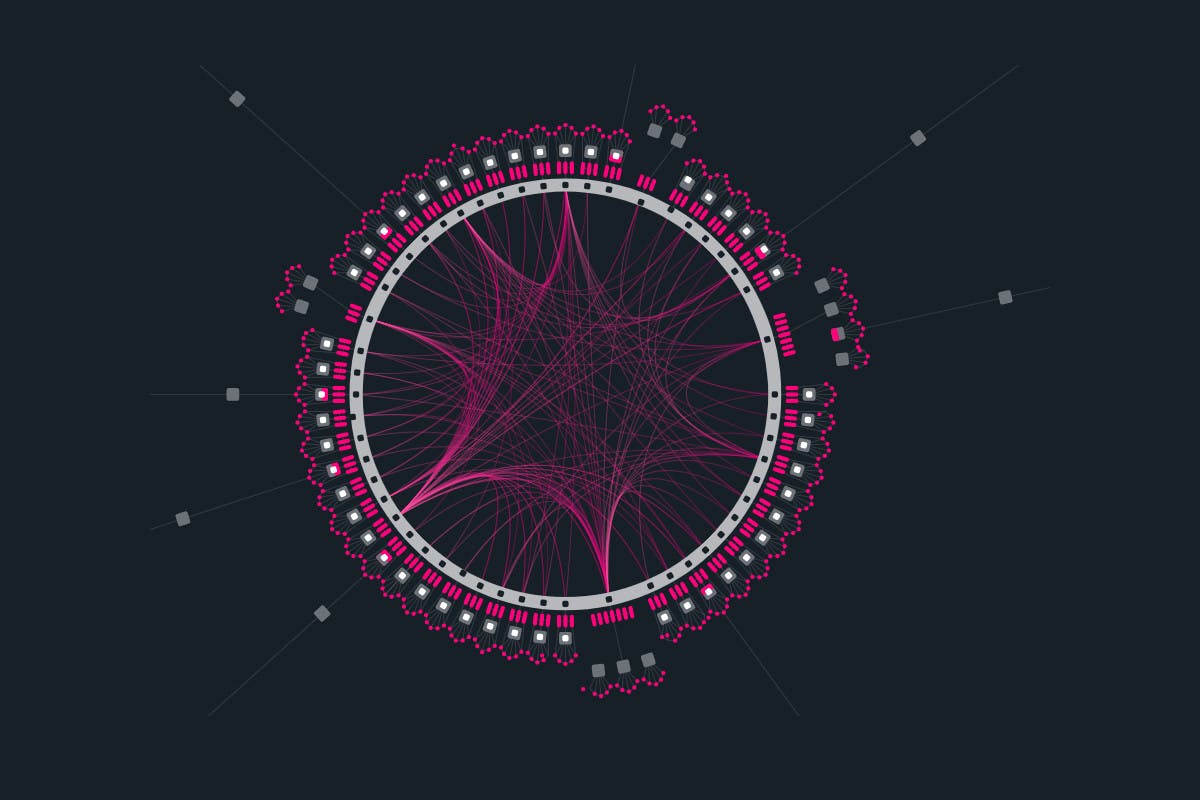The Importance of Blockchain Knowledge for Devs
Unlocking the Power of Blockchain: A Look into Polkadot's Potential for Developers
There are a lot of choices one can make when designing their application's tech stack. A person can choose from a myriad of languages, frameworks, and tools to help get the job done, and within that landscape of offerings, blockchain presents a powerful option in the developer toolkit. Unfortunately, it is all too often misunderstood, or what is read presents more hype than reality. In this article, discover some of the core benefits of blockchain as a technical choice, with a particular focus on Polkadot.
Let's dive in!
In this post, what topics will be covered? Feel free to jump to any specific section that is most relevant to you, or read the entire article from beginning to end, depending on what is most beneficial.
We will be discussing three distinct areas:
Enhancing trust and security
Trust and security are paramount concerns for developers when building applications. Fortunately, blockchain technology offers a compelling solution. The decentralized and immutable nature of blockchain inherently enhances trust and strengthens security in a variety of ways. Moreover, Polkadot elevates this even further with its distinctive approach to blockchain. It serves as a robust network for developers, equipped with its own set of features.
So, let's dig into it!
Blockchain technology relies on cryptographic techniques to ensure the security of data and transactions. Polkadot, just like other blockchains, takes advantage of advanced encryption algorithms to provide robust protection for your information. It's all about solid security that instills confidence in developers and users, guaranteeing the integrity of valuable data.
However, what sets Polkadot apart is its unique shared security model. By pooling the security resources of multiple para chains, independent blockchains connected to a central relay chain, Polkadot establishes a formidable defense mechanism. This shared security approach not only enhances network security but also relieves developers from the burden of setting up individual security infrastructures for each parachain.

Immutability is a defining feature of blockchain. Once data enters the Polkadot network, it becomes set in stone and cannot be modified by malicious actors. This transparency ensures that every transaction and activity can be audited and verified by anyone with access to the blockchain. This concept is often referred to as creating more truth and relying less on trust. Developers can leverage this transparency to create applications that promote accountability, such as supply chain systems that allow everyone to trace the entire journey of products.
Now, here's where Polkadot's approach really stands out. Its unique approach includes a shared security model. Multiple parachains (fancy word for independent sovereign blockchains as we mentioned before) connect to a central relay chain, pooling their security resources. It's like having an entire team defending your application. This shared security setup means that developers don't need to worry about setting up their own security infrastructure for each parachain. It's a win-win situation that increases the overall network security and protects against potential attacks.
This video is an excellent walkthrough of the entire history of Polkadot and the architectural decisions made that set it apart from other alternatives:
What is one prominent concept that is often associated with blockchain technology? If you guessed Merkle trees, you are correct!
Merkle trees play a significant role in many cryptographic models. These sophisticated data structures serve as powerful tools for verifying data integrity through the application of cryptographic techniques. In the context of blockchain technology, Merkle trees become particularly relevant. Within the blockchain, each block is associated with a Merkle root, an intricately crafted hash that encapsulates the entirety of transactions within that specific block. The utilization of Merkle roots enables users to efficiently and securely validate the authenticity and accuracy of transactions, effectively safeguarding historical data from any unauthorized modifications. This mechanism can be likened to an impregnable seal of trust, bolstering the reliability and immutability of the blockchain network.
[Merkle Root]
/ \
/ \
/ \
[Hash 0-1] [Hash 2-3]
/ \ / \
/ \ / \
/ \ / \
[Hash 0] [Hash 1] [Hash 2] [Hash 3]
| | | |
[Transaction 0] [Transaction 1] [Transaction 2] [Transaction 3]
In the diagram above you can see the following:
The "Merkle Root" is a hash value that represents all the transactions in a specific block in the blockchain. This is included in the block's header and provides a compact summary of all the transactions.
"Hash 0-1" is a hash of "Hash 0" and "Hash 1". Similarly, "Hash 2-3" is a hash of "Hash 2" and "Hash 3". These are intermediate nodes in the tree.
"Hash 0", "Hash 1", "Hash 2", and "Hash 3" are hashes of "Transaction 0", "Transaction 1", "Transaction 2", and "Transaction 3", respectively. These are the leaf nodes of the tree.
"Transaction 0", "Transaction 1", "Transaction 2", and "Transaction 3" represent the actual transaction data in the block.
With a Merkle tree, you can validate whether a specific transaction is included in a block with just a subset of the tree (not needing the full tree), which provides efficiency. And due to the cryptographic nature of hash functions, any change in any transaction would result in a different Merkle root, thus ensuring data integrity.
We've only scratched the surface here. In the section below, we'll dive deeper into Polkadot's governance framework and how it adds another layer of trust and security.
Boosting transparency
Blockchain technology provides developers with a powerful tool to increase transparency in their applications. One crucial aspect of transparency is the public nature of blockchain data, in which every transaction and activity is recorded on a decentralized ledger accessible to anyone on the network. This open accessibility enables scrutiny and verification, promoting accountability and trust. Developers can harness this transparency to create applications that allow users to validate and trace the entire history of their data and transactions.
Polkadot elevates the concept of transparency by incorporating an innovative on-chain governance model that sets it apart from other blockchain networks. On-chain governance is a term used to describe the decentralized decision-making process that takes place directly on the blockchain itself, rather than relying on external mechanisms or centralized authorities. This approach allows stakeholders to actively participate in proposing, discussing, and voting on various aspects of the network, such as protocol upgrades, network parameters, and other governance-related decisions.
By employing this transparent governance mechanism, Polkadot ensures that the development, evolution, and overall direction of the network are driven by the collective consensus of its participants. This fosters a sense of inclusivity and democratic decision-making, as every stakeholder has the opportunity to voice their opinions and contribute to the network's growth. Consequently, this open and collaborative environment empowers developers to actively engage in shaping the future of the network, advocating for changes that align with their specific application requirements and the broader needs of the community.
Furthermore, the transparent nature of Polkadot's on-chain governance model enables users to easily validate and trace the entire history of their data and transactions, as well as the decision-making processes that have shaped the network over time. This level of openness and accessibility not only promotes accountability and trust among participants but also encourages developers to harness the power of transparency in creating applications that cater to the ever-evolving needs of their users.
Polkadot's unique on-chain governance model takes transparency to its fullest potential by enabling decentralized decision-making directly on the blockchain. All decisions are made on-chain. This approach promotes inclusivity, democratic decision-making, and collective consensus, empowering developers to actively engage in the network's growth and advocate for changes that align with their application's requirements. The open and accessible nature of this governance model further bolsters accountability and trust.
One notable feature of Polkadot's governance model is OpenGov, a framework introduced on the canary network Kusama and expected to be implemented on Polkadot soon. OpenGov enables stakeholders to propose, discuss, and vote on a wide range of network upgrades and parameter changes. It fosters transparency by providing a platform for open discussions and debates among stakeholders, ensuring that decisions are made through a collaborative and community-driven process. This unique governance model empowers developers to have visibility into decision-making, actively participate in shaping the network's future, and align it with their application's needs.
The auditability of blockchain transactions is another aspect that enhances transparency. Every transaction recorded on the blockchain is immutable and verifiable, providing an indelible audit trail. Developers can utilize this feature to build applications that require transparency, auditability, and proof of authenticity. Supply chain systems built on Polkadot can enable users to trace the origin and journey of products, ensuring transparency and authenticity throughout the supply chain. Such transparency not only fosters trust among participants but also acts as a deterrent to fraudulent or malicious activities.
In addition to transparency in data and on-chain governance, Polkadot's interoperability further promotes transparency. It allows different blockchains to communicate and share information, facilitating data exchange and collaboration between various applications and organizations. This interoperability enables developers to build applications that seamlessly interact with other blockchains, leveraging their data and functionalities. By integrating and sharing data across different chains, developers can foster transparency, enhance collaboration, and create innovative solutions that transcend organizational boundaries.
The public nature of blockchain data, coupled with on-chain governance and interoperability, empowers developers to build applications that are accountable, traceable, and shaped by collective decision-making. The governance model, including the upcoming OpenGov framework, ensures transparent and community-driven decision-making processes. Together, these aspects of transparency pave the way for new possibilities and drive the adoption of innovative and trustworthy applications on the Polkadot network.
Let's now look at another issue that is important for devs when considering any choice for their tech stack, namely accessibility across all devices. Blockchains can be often notoriously resource intensive, which can make them hard to access and participate in with mobile devices and other less computationally powerful machines. How can this be addressed?
Ensuring compatibility with all devices
Light clients play a crucial role in ensuring compatibility across different device types, offering a range of benefits for developers and users alike. Their lightweight nature and simplified protocols allow devices with limited resources, such as smartphones or IoT devices, to seamlessly access blockchain networks. This broad compatibility facilitates the widespread adoption of blockchain technology across diverse device ecosystems, eliminating barriers to entry and expanding the reach of decentralized applications.
One notable advantage of light clients is their ability to provide faster synchronization with the blockchain network. Unlike full nodes that require downloading and verifying the entire blockchain, light clients selectively fetch and validate specific portions relevant to the user's needs. This selective synchronization significantly reduces the time required to access up-to-date blockchain information, enhancing the overall user experience by providing near-instantaneous access to the latest data.
Moreover, light clients contribute to the decentralization and security of blockchain networks. By connecting to remote full nodes, they distribute the load of network validation, reducing reliance on a single centralized entity. This distributed approach enhances the resilience of the network, mitigates the risk of single points of failure, and fosters a more robust and censorship-resistant ecosystem.
In the context of Polkadot, light clients are empowered even further through Substrate Connect. Substrate Connect is a library that enables developers to build light clients for Substrate-based blockchains, including Polkadot and its canary network Kusama. With Substrate Connect, developers can create light clients that seamlessly interact with the Polkadot ecosystem, leveraging its interoperability and shared security model.

By enabling compatibility across various devices, enhancing synchronization speed, and promoting decentralization, light clients, especially when combined with Substrate Connect, offer an important solution for achieving broad accessibility and compatibility. Developers can leverage light clients to ensure seamless integration across smartphones, IoT devices, and other resource-constrained devices, facilitating the widespread adoption of decentralized applications. Additionally, the faster synchronization and decentralized validation process offered by light clients enhance the user experience while maintaining the integrity and security of the underlying blockchain network.
There's a great video from the Sub0 developer event not so long ago that explains how to use Substrate Connect and how it is a faster and more reliable replacement for other alternatives:
By adopting light client solutions, developers can empower users to seamlessly access blockchain technology across diverse devices, fostering the adoption of decentralized applications and expanding the reach of blockchain networks across different device types, providing a range of benefits for developers and users.
We've covered a substantial amount in this post! If it seems like a whirlwind, that's because it is. There will be two more posts in this series that delve deeper into Polkadot's architecture and how to begin building applications within its ecosystem. We haven't even scratched the surface on those topics, and there's so much to discuss regarding Substrate, the modular framework for building blockchains, and ink!, the Rust-based DSL for writing smart contracts. Don't worry, we'll get there!
In the meantime, I encourage you to check out the Polkadot Wiki, the Substrate documentation and the ink! documentation to continue your learning.
